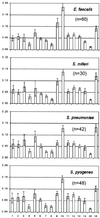Identification of Enterococcus, Streptococcus, and Staphylococcus by multivariate analysis of proton magnetic resonance spectroscopic data from plate cultures
- PMID: 11474013
- PMCID: PMC88260
- DOI: 10.1128/JCM.39.8.2916-2923.2001
Identification of Enterococcus, Streptococcus, and Staphylococcus by multivariate analysis of proton magnetic resonance spectroscopic data from plate cultures
Abstract
A new fingerprinting technique with the potential for rapid identification of bacteria was developed by combining proton magnetic resonance spectroscopy ((1)H MRS) with multivariate statistical analysis. This resulted in an objective identification strategy for common clinical isolates belonging to the bacterial species Staphylococcus aureus, Staphylococcus epidermidis, Enterococcus faecalis, Streptococcus pneumoniae, Streptococcus pyogenes, Streptococcus agalactiae, and the Streptococcus milleri group. Duplicate cultures of 104 different isolates were examined one or more times using (1)H MRS. A total of 312 cultures were examined. An optimized classifier was developed using a bootstrapping process and a seven-group linear discriminant analysis to provide objective classification of the spectra. Identification of isolates was based on consistent high-probability classification of spectra from duplicate cultures and achieved 92% agreement with conventional methods of identification. Fewer than 1% of isolates were identified incorrectly. Identification of the remaining 7% of isolates was defined as indeterminate.
Figures



Similar articles
-
Rapid detection of Gram-positive organisms by use of the Verigene Gram-positive blood culture nucleic acid test and the BacT/Alert Pediatric FAN system in a multicenter pediatric evaluation.J Clin Microbiol. 2013 Nov;51(11):3579-84. doi: 10.1128/JCM.01224-13. Epub 2013 Aug 21. J Clin Microbiol. 2013. PMID: 23966484 Free PMC article.
-
Evaluation of rapid identification of gram-positive cocci in positive blood cultures by use of the AutoMicrobic system Gram-Positive Identification Card.J Clin Microbiol. 1984 Aug;20(2):171-4. doi: 10.1128/jcm.20.2.171-174.1984. J Clin Microbiol. 1984. PMID: 6436292 Free PMC article.
-
Rapid identification of Gram-positive pathogens and their resistance genes from positive blood culture broth using a multiplex tandem RT-PCR assay.J Med Microbiol. 2013 Feb;62(Pt 2):223-231. doi: 10.1099/jmm.0.050385-0. Epub 2012 Nov 8. J Med Microbiol. 2013. PMID: 23139396
-
The present state of species within the genera Streptococcus and Enterococcus.Int J Med Microbiol. 2007 Jun;297(3):133-50. doi: 10.1016/j.ijmm.2006.11.008. Epub 2007 Mar 30. Int J Med Microbiol. 2007. PMID: 17400023 Review. No abstract available.
-
Classification and overview of the genera Streptococcus and Enterococcus.Soc Appl Bacteriol Symp Ser. 1997;26:1S-11S. Soc Appl Bacteriol Symp Ser. 1997. PMID: 9436312 Review. No abstract available.
Cited by
-
Gram-negative and Gram-positive bacterial infections give rise to a different metabolic response in a mouse model.J Proteome Res. 2012 Jun 1;11(6):3231-45. doi: 10.1021/pr201274r. Epub 2012 May 3. J Proteome Res. 2012. PMID: 22483232 Free PMC article.
-
Metabolomic investigation of the bacterial response to a metal challenge.Appl Environ Microbiol. 2009 Feb;75(3):719-28. doi: 10.1128/AEM.01771-08. Epub 2008 Dec 1. Appl Environ Microbiol. 2009. PMID: 19047385 Free PMC article.
-
An Escherichia coli strain, PGB01, isolated from feral pigeon Faeces, thermally fit to survive in pigeon, shows high level resistance to trimethoprim.PLoS One. 2015 Mar 9;10(3):e0119329. doi: 10.1371/journal.pone.0119329. eCollection 2015. PLoS One. 2015. PMID: 25750990 Free PMC article.
-
Assessment of inhibitory potency of antibiotics by MRI: apparent T2 as a marker of cell growth.MAGMA. 2006 Nov;19(5):247-55. doi: 10.1007/s10334-006-0053-z. Epub 2006 Nov 10. MAGMA. 2006. PMID: 17096123
-
Rapid identification of Candida species by using nuclear magnetic resonance spectroscopy and a statistical classification strategy.Appl Environ Microbiol. 2003 Aug;69(8):4566-74. doi: 10.1128/AEM.69.8.4566-4574.2003. Appl Environ Microbiol. 2003. PMID: 12902244 Free PMC article.
References
-
- Bax A, Davis D. MLEV-17-based two-dimensional homonuclear magnetization transfer spectroscopy. J Magn Reson. 1986;65:355–360.
-
- Bradley E, Tibshirani R. An introduction to the bootstrap. London, United Kingdom: Chapman & Hall; 1993.
-
- Braun S, Kalinowski H-O, Berger S. 150 and more basic NMR experiments. New York, New York: Wiley-VCH; 1998.
-
- Cohen J. Weighted Kappa: Nominal scale agreement with provision for scaled disagreement or partial credit. Psychol Bull. 1968;70:213–218. - PubMed
Publication types
MeSH terms
Substances
LinkOut - more resources
Full Text Sources
Other Literature Sources
Molecular Biology Databases

